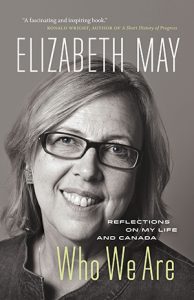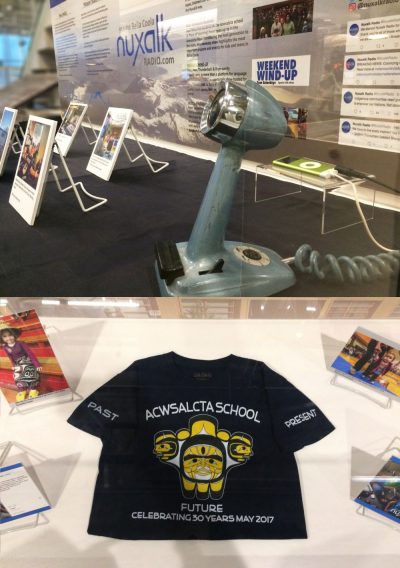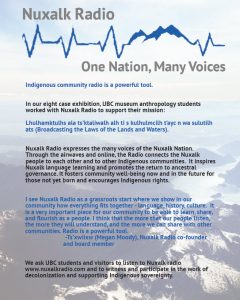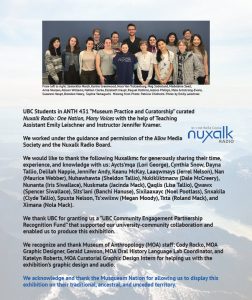BC History Digitization Program – 2018-2019 Recipients
Eighteen projects have been named as successful recipients of the 2018-2019 B.C. History Digitization Program (BCHDP) funding awards.
The digitization program, an initiative of the Irving K. Barber Learning Centre, was launched in 2006. It provides matching funds that help libraries, archives, museums and other organizations digitize unique historical items, including images, print and sound materials.
The Irving K. Barber Learning Centre funding totaled nearly $180,000 for the 2018-2019 round. Altogether, the B.C. History Digitization program has provided more than $1 million for more than 100 projects throughout British Columbia.
This year’s diverse range of projects includes the digitization of newspapers and publications from various B.C. regions, video works from the 1970s by Vancouver artists, the Ann Gomer Sunahara fonds, documents and videos relating to women’s labour history, the last phase of the British Columbia Sessional papers project, bird taxidermy, product packaging, and more.
Congratulations to this year’s recipients!
To view a complete listing of the projects and their descriptions:
BC History Digitization Program – 2018 Projects
In September 2006, the Irving K. Barber Learning Centre at the University of British Columbia Library announced the BC History Digitization Program. The focus of the program is to promote increased access to British Columbia’s historical resources, including providing matching funds to undertake digitization projects that will result in free online access to our unique provincial historical material. Below is a list of successful applicants for 2018.
Council Committee Minutes
City of Coquitlam
$3,666.43
The series from the Coquitlam Council and Office of the City Clerk fonds consists of the minutes of Council Committees from 1946 to 2017 including: the Board of Variance, Parks and Recreation Committee (by the mid-1990s the Leisure and Parks Services Committee), Land Use Committee (originally the Town Planning Commission), Bargaining Commission, Burke Mountain Commission, Civil Defense Commission, Committee of the Whole, Court of Revision, Financial Commission, Historical Society Commission, joint Council for Three Municipalities Committee, Land Sale Commission, Library Commission, Safety Committee, Sanitation Committee, Street Lighting Commission, Public Hearings from 1959 to 1978, Public Works Committee, Water Commission and the Zoning Board of Appeal.
Steffens-Colmer Studios and Don Coltman Company Photographs Digitization Project
City of Vancouver Archives
$15,000
These photographs belong to the Steffens Colmer Studios and Don Coltman Company Photographs series within the Williams Bros. Photographers fonds. Con Coltman was the manager of the Vancouver-based Steffens-Colmer photograph studios that closed in 1955. This project will digitize 5.300 4×5, 5×7 and 8×10 photographic negatives from the Steffens-Colmer Studios and Don Coltman series.
TCR Open Access Archive
Capilano Review Contemprary Arts Society
$15,000
The TCR Open Access Archive will make available the magazine’s entire 45-year publication history. As such, all issues from 1972 onwards will require digitization, a total of 133 issues and approximately 16,000 pages. The material is ready for digitization.
Association of College and University Employees Local 1 Digital Collection
CUPE 2950 – Clerical, Library and Theatre Workers at the University of British Columbia
$9,500
This phase of the project will be digitizing 9,750 pages of materials. The majority of the fonds is text-based and consists of meeting minutes, newsletters, correspondence, photos, newspaper clippings, and other organization records from across the Locals.
JHSBC Publication Digitization Project
Jewish Museum and Archives of British Columbia
$2,500
The JHSBC Publication Digitization project is an opportunity to share widely online, in digitized, searchable, and indexed format, the prolific work that the JHSBC accomplished in its early years; bringing back into the spotlight the publications the Scribe and the Chronicle, and the resources they can provide. Through the digitization of approximately 3400 pages of unique research and writing the JMABC will be able to open a new wealth of information to research to one and all.
The Legacy Project
Karen Jamieson Dance Society
$1,210
This project will digitize 25 VHS containing roughly 26hrs of documentation, 3 Betamax containing 2hrs of documentation, and 1 Sony Helical open reel with roughly 30mins of documentation. This material has been selected from around 175 VHS, Cassette, Mini-DV and Betamax because of the importance and rarity of the documentation these carriers can contain. The performances, interviews, and practices recorded will provide vital insight in to Vancouver’s cultural heritage over a 20 year span.
The Politics of Racism Project
Nikkei National Museum
$12,043
The Nikkei National Museum’s (NNM) Politics of Racism Project (PRP) aims to digitize the Ann Gomer Sunahara fonds, a recently acquired donation that consists of original sound recordings and her groundbreaking research. The oral histories feature significant individuals. The PRP also aims to digitize and make accessible materials from the Jitaro and Sumiko Tanaka collection, the Roy Ito collection, and the Henry and Yvonne Wakabayashi collection.
The North Pacific Cannery Archival Image Digitization Project
Port Edward Historical Society
$6,450
The North Pacific Cannery Archival Image Collection contains approximately 4000 images in total, which can be divided into two main categories: 1) “historic” images that depict the fishing and canning activities primarily on BC’s north coast (approximately 2500 images) and 2) “contemporary” images relating to the development of the North Pacific Cannery site into a museum and National Historic Site, including activities of the Port Edward Historical Society (and previous operators of the of the North Pacific Cannery NHS) and preservation work undertaken at the site. (approximately 1500 images). Of the 4000 images selected for digitization, approximately 80 percent are photographic prints, while the other 20 percent are slides and some negatives.
Prince George Newspapers Digitization Project
Prince George Public Library
$8,500
The Prince George Free Press was published from October 31, 1994 to May 1, 2015. This independent community newspaper included local news, community events and classified ads. It offered a different voice and different perspective from the Citizen on local and mainstream news. This project will digitize issues from 2004 to May 2015, when the Prince George Free Press ceased publication.
The Women’s Labour History Project Video Interviews
VIVO Media Arts Centre
$4,000
The WLHP (1978-1995) was a non-profit society led by Sara Diamond and included a dynamic staff of women who have since moved on to significant careers in the arts, media industry, social activism, and Indigenous rights. This project will digitize 34.5 hours of interview footage on 93 U-Matic and Betacam videotapes.
Prry the Poster Man’ Collection
Simon Fraser University Library
$8,803.33
Since 1978, Perry Giguere (aka ‘Perry the Poster Man’) has made a business out of putting up promotional posters all over Vancouver, British Columbia, always holding on to an extra copy or two at the end of a job. The result is a comprehensive archives of approximately 150,000 posters documenting cultural, social and political activities in Vancouver over the past four decades. Digitization will focus on 800 posters of varying sizes, techniques, and subject matter pre-selected from the total collection of nearly 1,400 posters dating from ca. 1980 to 2015.
Thompson-Nicola Historical Newspaper Digitization Project
Thompson-Nicola Regional District Library System
$15,000
The Kamloops Daily Sentinent, also known as the Inland Sentinet, was the longest running newspaper in Kamloops, spanning from the 1880s to 1987. This project will digitize as much of the Inland Sentinel as possible, starting in 1885 and finishing in 1942.
Vancouver film and video artists of the 1970s
Morris and Helen Belkin Art Gallery
$11,740
This project aims to digitize video works from the 1970s by Vancouver artists Glenn Lewis, Eric Metcalfe, Michal Morris, and Vincent Trasov. These four artists were founding members of the Western Front artist-run centre in 1973 and were influental in the interdisciplinary art scene of the time. The project will digitize ca. 22 hours (97 items) of footage.
Digitization of BC Sessional Papers, 1965; 1970-1982
UBC Library – Humanities and Social Sciences Division & Digital Initiatives
$5,470
This project proposes to continue digitizing the next selection of the British Columbia Sessional papers consisting of 28 volumes (1965; 1970-1982). So far, with the generous support of the BCHDP grant, we have digitized 90 years (1876-1967) of the Sessional Papers and we hope to complete the entire run of the papers which end in 1982. In addition to the papers, there are also accompanying fold out maps and charts.
Digitizing the Nanaimo Daily Free Press (1874-1928) and Cowichan Leader (1905-1928)
Vancouver Island University
$15,000
The proposed project plans to digitize the years out of copyright for two of our local papers on microfilm: 1) Cowichan Leader, 1905-1928 – 8 reels of microfilm 2) Nanaimo Daily Free Press, 1874-1928 – 50 reels of microfilm. The anticipated output is 34,800 digitized images (600 images per reel).
Digitization of the Victoria Daily Colonist newspaper: 1971-1980
University of Victoria Libraries
$15,000
Thanks to previous funding and support from the Ike Barber Learning Centre at various times, The University of Victoria Libraries has already digitized the Daily Colonist newspaper from 1858-1970. For the purpose of the 2018-2019 granting cycle, we are requesting funding to digitize additional reels from 1971-1980. This digitization initiative will not only significantly enhance our existing collection, but create further historical impact by making more of this important and popular resource material freely and publicly available online.
BC Bird Taxidermy and Product Packaging Digitization Project
Museum of Vancouver
$10,000
The Museum of Vancouver (Mov) proposes to digitize two cateories of artefacts with significant British Columbia stories to tell. The collections selected are bird taxidermy and product packaging. The artefacts selected includes 206 taxidermied birds and 1236 pieces of product packaging for a grand total of 1442 artefacts digitized.
Early Vancouver Photography Studios – Glass Plate Negatives
Vancouver Public Library
$11,140.42
The VPL plans to digitize the remaining 2,050 images from VPL’s Glass Plate Negative Collection and add them to their online historical photographs database. The collection depects streetviews, buildings, landscaes and panoramas of Vancouver and British Columbia from the 1890s to the 1920s.
Dr. Susan Parker – Beyond Borges: Telling Tales of Future Libraries
Webcast sponsored by the Irving K. Barber Learning Centre and hosted by UBC iSchool. In the post-print information era, how do libraries manage scholarly information? Academic libraries have developed alongside technology, but technology is now changing the structures of information creation, dissemination, retrieval, and preservation. The use of technology in and by libraries, and by the scholars whom they serve, has raised new questions for librarians about their work and its place within the academy.
This presentation explores how forces and critical issues that are now shaping academic libraries are deepening their engagement with scholars and helping to build platforms and relationships that expand the pathways of creation, discovery, learning, and dialogue. We will consider several of these phenomena and how they may contribute to expanded roles for libraries and a new era of library work.
Speaker Bio
Susan E. Parker was appointed University Librarian at the University of British Columbia starting on September 1, 2017. She was previously the Deputy University Librarian at UCLA from 2005 until mid-2017, where she had a broad administrative and operations portfolio that included budget and fiscal planning, space planning and renovation, assessment, programming, and various user services. From 2015-2017, she served as interim Director of Library Special Collections. She was Associate Dean of the Oviatt Library at California State University, Northridge from 1997-2005.
Parker is known as a speaker and author of numerous publications on library leadership and disaster planning in libraries. Her ALA, LAMA, and ACRL service extends over more than 30 years. She earned a B.A. in History and English from Earlham College, an M.A. in U.S. history from Indiana University, a Ph.D. in Organizational Psychology from Capella University, and the M.L.S. from Queens College, City University of New York. Parker was a member of the 2003 class of UCLA Senior Fellows and a member of the 2013-15 cohort of ARL Leadership Fellows.
iSchool Colloquia Series
Select Articles and Books Available at UBC Library
Susan, E. Parker. (2012). Innovation and Change: Influences of Pre-Disaster Library Leadership in a Post-Disaster Environment. Advances in Library Administration and Organization, 31, 121-204. doi:10.1108/S0732-0671(2012)0000031006. [Link]
UBC Library Research Guides
Lead, Succeed, and Inspire: An Evening with Changemakers
Lead, Succeed and Inspire: An Evening with Changemakers
Wednesday, March 14th, 2018 at 6 pm
In recognition of International Women’s Day and the International Day for the Elimination of Racism, join us for an evening of inspirational engagement.
On a daily basis we are reminded of the importance and value of creating space for dialogue on gender and racial equality as a vehicle for creating and sustaining meaningful change. This event will recognize the lives and leadership of women and people of colour as they share what it takes to lead, succeed, and inspire change.
Engage in dialogue and exchange ideas with UBC alumni, faculty, and community members who will explore issues of race and gender through an intersectional lens, and discuss efforts to make our communities, and the world, a better place for all.
Opening remarks by Minister Jody Wilson-Raybould.
Moderator
Anita Bathe – CBC Reporter, News at 6pm
Speakers
Leonora C. Angeles, Ph.D – Associate Professor, Institute for Gender, Race, Sexuality and Social Justice
Patricia Barkaskas – Academic Director, Indigenous Community Legal Clinic; Instructor, Peter A. Allard School of Law
Cicely Blain – Writer, facilitator, activist, artist, and founder, Black Lives Matter Vancouver
Shushma Datt, OBC – Top Indo-Canadian Broadcaster / i.t. Productions, SPICE RADIO 1200 AM
Event Host
Dr. Jennifer Love – UBC Senior Advisor on Women Faculty
2018 UBC Reads Sustainability with Elizabeth May
Who We Are with Elizabeth May
Join leader of the Green Party of Canada and Member of Parliament, Elizabeth May, for a riveting discussion on Canada’s role in a challenging time.
In Who We Are: Reflections on my life and on Canada, Elizabeth draws from her life experience, growing up in a politically active family in the US, to moving to a small village on Cape Breton Island. Forty five years after leaving the US as a teenager, she will reflect on the decline of US society, the rise of ignorance and the challenge for Canada. The Paris Agreement and the impact of Trump will be explored with a surprisingly hopeful conclusion.
More About Elizabeth May

Elizabeth May is Leader of the Green Party of Canada and its first elected Member of Parliament, representing Saanich-Gulf Islands in southern Vancouver Island. In 2005, Elizabeth May was made an Officer of the Order of Canada in recognition of her decades of leadership in the Canadian environmental movement.
She graduated from Dalhousie Law School and was admitted to the Bar in both Nova Scotia and Ontario. She practiced law in Ottawa with the Public Interest Advocacy Centre prior to becoming Senior Policy Advisor to the federal minister of the Environment (1986- 1988). For seventeen years Elizabeth served as Executive Director of the Sierra Club of Canada. A proud mother and grandmother, she lives in Sidney, British Columbia.
Elizabeth is the author of eight books, including her most recent book Who We Are: Reflections on my life and on Canada.
AABC Webcast Roundtable: Audiovisual Records in a Digital Age
AABC Webcast Roundtable: Audiovisual Records in a Digital Age
The AABC is pleased to partner with the Irving K. Barber Learning Centre at UBC to present our 7th webcast roundtable on “Audiovisual Records in a Digital Age”.
Motion picture films and audio and video recordings are found in every archival collection. These visual records play an important part of documenting our history but are at risk in our modern digital age due to media degradation and format obsolescence. Our panel of speakers will share their experiences managing audiovisual records and their thoughts on access, preservation and digitization.
Joining our roundtable will be:
• Jana Grazley – Digital Archivist, City of Vancouver Archives
• Karen Knights – Manager, Crista Dahl Media Library & Archive, VIVO Media Arts Centre
• Ember Lundgren – Preservation Manager, Archives and Museum Operations, Royal BC Museum
• Shyla Seller – Archivist, Simon Fraser University Archives
• Kristy Waller – Archivist, Western Front
How can you participate?
We invite our membership and colleagues near and far to take part in the roundtable. You can take part by watching online and sending in your questions and comments that will be incorporated into our discussion.
Email your comments and questions to aabc.advisor@aabc.ca
Send your comments and questions on Twitter using #aabcav
Previous webcasts can be found on the AABC website at http://aabc.ca/events/webcast-roundtables/
 Date: March 1 to April 3, 2018
Date: March 1 to April 3, 2018
